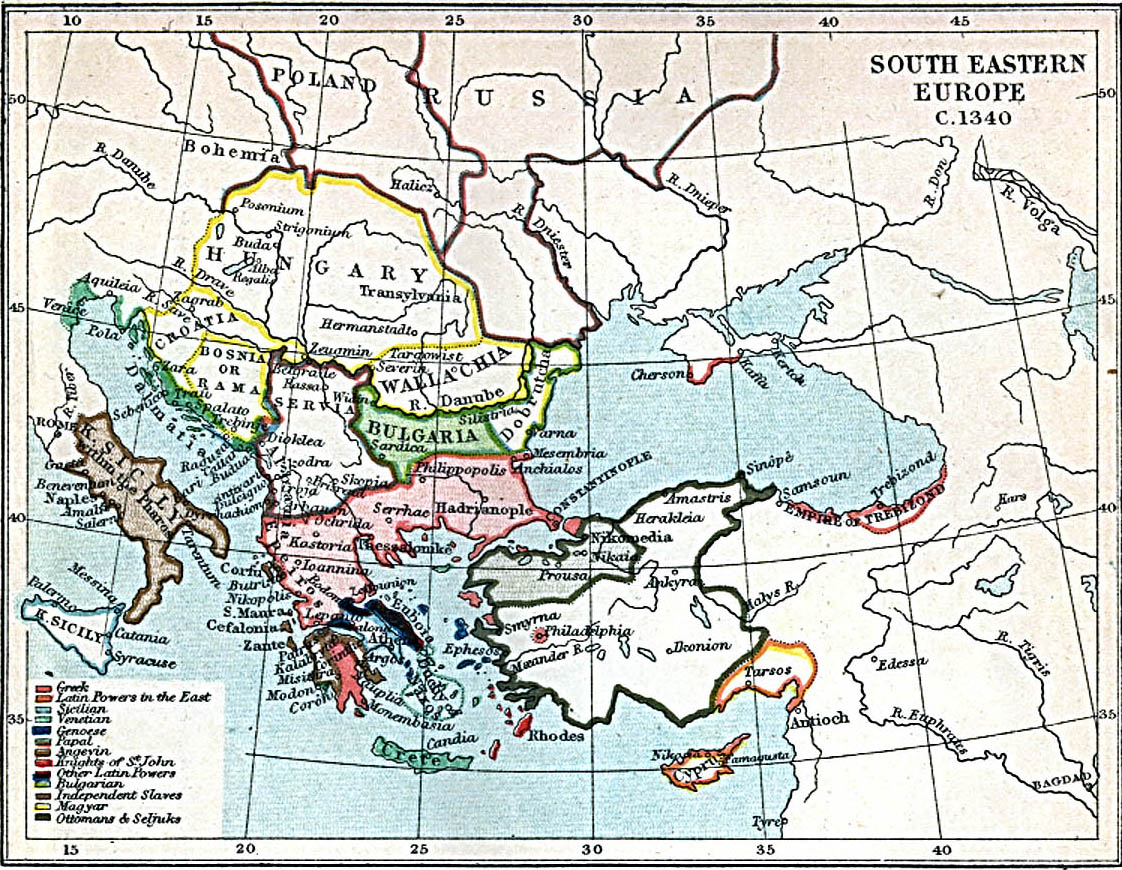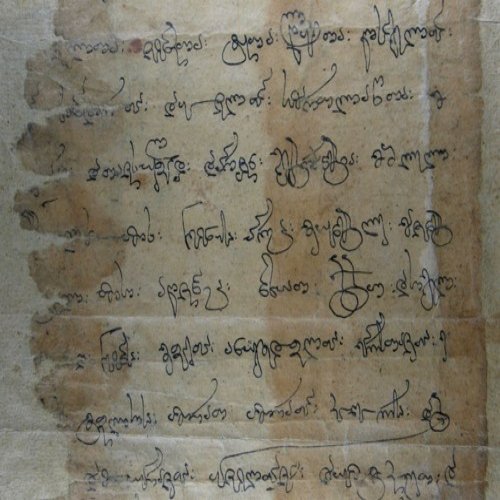|
Anna Of Trebizond
Anna Anachoutlou ( gr, Ἄννα Μεγάλη Κομνηνὴ Ἀναχουτλοῦ, Anna Megalē Komnēnē Anachoutloū; died 3 September 1342) ruled the Empire of Trebizond from 1341 to 1342. She was the eldest daughter of the List of Trapezuntine emperors, Trapezuntine emperor Alexios II of Trebizond, Alexios II Megas Komnenos () and had joined a convent as a nun during her father's reign. After the death of her father, Anna's brother Andronikos III of Trebizond, Andronikos III (), her nephew Manuel II of Trebizond, Manuel II (1332) and her other brother Basil of Trebizond, Basil () reigned in rapid succession. After Basil's death, his widow Irene Palaiologina of Trebizond, Irene Palaiologina, genealogically unconnected to the ruling Grand Komnenos dynasty of Trebizond, seized power as empress regnant. In June/July 1341, Anna escaped from her convent and rapidly began rallying support to fight against Irene. Despite being a woman and up until recently a nun, and there being s ... [...More Info...] [...Related Items...] OR: [Wikipedia] [Google] [Baidu] |
List Of Trapezuntine Emperors
The Trapezuntine emperors were the rulers of the Empire of Trebizond, one of the successor states of the Byzantine Empire founded after the Fourth Crusade in 1204, until its fall to the Ottoman Empire in 1461. All but two of the Trapezuntine rulers belonged to the Komnenos dynasty, which had previously ruled the Byzantine Empire from 1081 to 1185, and they initially claimed to represent the legitimate line of Roman emperors, in opposition to the Latin Empire in Constantinople, the Laskaris dynasty of the Nicene Empire, and the Komnenos Doukas family of Epirus and Thessalonica. To emphasize their dynastic claim, Trapezuntine emperors from the late 13th century onwards styled themselves as (, ). Out of the Byzantine claimants that emerged in 1204 and thereafter, the Trapezuntine emperors, despite their illustrious descent, had perhaps the worst position. Not only were they far away from Constantinople in a peripheral province of the empire, but the reputation of the Komnenoi had be ... [...More Info...] [...Related Items...] OR: [Wikipedia] [Google] [Baidu] |
George V Of Georgia
George V the Brilliant ( ka, გიორგი V ბრწყინვალე, ''Giorgi V Brtskinvale''; also translated as the ''Illustrious'', or ''Magnificent''; 1286/1289–1346) was King of Georgia from 1299 to 1302 and again from 1314 until his death in 1346. A flexible and far-sighted politician, he recovered Georgia from a century-long Mongol domination, restoring the country's previous strength and Christian culture. Reign George was born to King Demetrius II the Self-sacrificing and his third wife Natela, daughter of Beka I Jaqeli, prince and Atabeg of Samtskhe. Demetrius was executed by the Mongols in 1289, and the little prince George was carried to Samtskhe to be reared at the court of his maternal grandfather (Beka). In 1299, the Ilkhanid khan Ghazan installed him as a rival ruler to George's elder brother, the rebellious Georgian King David VIII. However, George's authority did not extend beyond the Mongol-protected capital Tbilisi, so George was referred ... [...More Info...] [...Related Items...] OR: [Wikipedia] [Google] [Baidu] |
Constantinople
la, Constantinopolis ota, قسطنطينيه , alternate_name = Byzantion (earlier Greek name), Nova Roma ("New Rome"), Miklagard/Miklagarth (Old Norse), Tsargrad ( Slavic), Qustantiniya (Arabic), Basileuousa ("Queen of Cities"), Megalopolis ("the Great City"), Πόλις ("the City"), Kostantiniyye or Konstantinopolis ( Turkish) , image = Byzantine Constantinople-en.png , alt = , caption = Map of Constantinople in the Byzantine period, corresponding to the modern-day Fatih district of Istanbul , map_type = Istanbul#Turkey Marmara#Turkey , map_alt = A map of Byzantine Istanbul. , map_size = 275 , map_caption = Constantinople was founded on the former site of the Greek colony of Byzantion, which today is known as Istanbul in Turkey. , coordinates = , location = Fatih, İstanbul, Turkey , region = Marmara Region , type = Imperial city , part_of = , length = , width ... [...More Info...] [...Related Items...] OR: [Wikipedia] [Google] [Baidu] |
Irene Of Trebizond
Irene of Trebizond (died around 1382) was an Empress consort of Trebizond as the bigamous wife of Basil of Trebizond. She had an important position in the regency of her son Alexios III of Trebizond in 1341-1352. Life Not much is known of Irene's early life before she became Basil's mistress; "the Byzantine historian called era courtesan, but the Trapezuntine chronicler a lady of Trebizond," writes William Miller. She had two sons with him before he married her in 1339. This marriage engendered much protest from the Patriarch of Constantinople, John XIV Kalekas. Their marriage only lasted about nine months before he died after a short illness; Miller writes again, "It was whispered that the discarded Empress had murdered him privily, and her conduct lent some colour to the suspicion, for she was evidently prepared to profit by his demise." Irene Palaiologina, the so-called "discarded Empress", and her supporters seized power immediately and sent Irene of Trebizond with her two y ... [...More Info...] [...Related Items...] OR: [Wikipedia] [Google] [Baidu] |
Andronikos III Palaiologos
, image = Andronikos_III_Palaiologos.jpg , caption = 14th-century miniature. Stuttgart, Württembergische Landesbibliothek. , succession = Byzantine emperor , reign = 24 May 1328 – 15 June 1341 , coronation = 2 February 1325 , cor-type1 = Coronation , predecessor = Andronikos II Palaiologos , successor = John V Palaiologos , spouse = Irene of BrunswickAnna of Savoy , issue = Irene, Empress of Trebizond Maria (renamed Irene)John V Palaiologos Michael Palaiologos , issue-link=#Family , issue-pipe = more... , house = Palaiologos , father = Michael IX Palaiologos , mother = Rita of Armenia , birth_date = 25 March 1297 , birth_place = Constantinople, Byzantine Empire(now Istanbul, Turkey) , death_date = 15 June 1341 (aged 44) , death_place = Constantinople, Byzantine Empire , burial_place= Andronikos III Palaiologos ( grc-x-medieval, Ἀνδρόνικος Δούκ� ... [...More Info...] [...Related Items...] OR: [Wikipedia] [Google] [Baidu] |
List Of Byzantine Emperors
This is a list of the Byzantine emperors from the foundation of Constantinople in 330 AD, which marks the conventional start of the Eastern Roman Empire, to its fall to the Ottoman Empire in 1453 AD. Only the emperors who were recognized as legitimate rulers and exercised sovereign authority are included, to the exclusion of junior co-emperors (''symbasileis'') who never attained the status of sole or senior ruler, as well as of the various usurpers or rebels who claimed the imperial title. The following list starts with Constantine the Great, the first Christian emperor, who rebuilt the city of Byzantium as an imperial capital, Constantinople, and who was regarded by the later emperors as the model ruler. It was under Constantine that the major characteristics of what is considered the Byzantine state emerged: a Roman polity centered at Constantinople and culturally dominated by the Greek East, with Christianity as the state religion. The Byzantine Empire was the direct lega ... [...More Info...] [...Related Items...] OR: [Wikipedia] [Google] [Baidu] |
Aspron
The ''aspron'' ( el, ἄσπρον), from Latin ''asper'', was a late Byzantine name for silver or silver-alloy coins. The Latin word ''asper'' originally meant "rough", but had gradually acquired the connotation of "fresh" or "freshly minted", i.e. not worn smooth by use, and, especially when referring to silver, "white", by the imperial period. It acquired a technical meaning in the 12th century, when the Byzantines began to refer to the billon '' trachy'' coin, which was issued in a blanched state, as an ''aspron''. The same name was also sometimes applied to the contemporary electrum ''trachy'' as well. The name re-appears in the 14th–15th centuries as a generic name for silver coinage, such as the Byzantine ''doukatopoulon'' or the Turkish '' akçe''. The 15th century account books of the Venetian merchant-banker Giacomo Badoer lists several cities and governments that coined aspers, which included Trebizond, Caffa, Simisso (or Samsun), Tana, and Rhodes Rhodes (; ... [...More Info...] [...Related Items...] OR: [Wikipedia] [Google] [Baidu] |
Beka I Jaqeli
Beka I Jaqeli ( ka, ბექა I ჯაყელი) (c. 1240 – 1306) was a Georgian ruling prince (''mtavari'') of Samtskhe (1285–1306). His principality included Samtskhe, Adjara, Shavsheti, Klarjeti, Lazia (Chaneti), Tao, Kola, Artaani and most of Javakheti. His realm stretched from Tashiskari (modern Khashuri District) to Karnu-kalaki (now Erzurum) and the Black Sea. During his reign, Samtskhe-Saatabago existed as a politically independent entity from the Georgian Kingdom. Beka was a vassal of the Ilkhanate, paid regular tributes and participated in their campaigns. Despite being independent, Samtskhe still maintained some kind of relations with Georgia and Beka himself was given a title of Mandaturukhutsesi (the elder - ''first in rank'' - Mandator) by Georgian king.Georgian Soviet Encyclopedia, Volume 2, page 345-346, Tbilisi, 1977 At the time of Beka's rule, the Turks became more active the Southwest borders, from the Sultanate of Rum. After a series of invasions, he ma ... [...More Info...] [...Related Items...] OR: [Wikipedia] [Google] [Baidu] |
Mongol Empire
The Mongol Empire of the 13th and 14th centuries was the largest contiguous land empire in history. Originating in present-day Mongolia in East Asia, the Mongol Empire at its height stretched from the Sea of Japan to parts of Eastern Europe, extending northward into parts of the Arctic; eastward and southward into parts of the Indian subcontinent, attempted invasions of Southeast Asia and conquered the Iranian Plateau; and westward as far as the Levant and the Carpathian Mountains. The Mongol Empire emerged from the unification of several nomadic tribes in the Mongol homeland under the leadership of Temüjin, known by the more famous title of Genghis Khan (–1227), whom a council proclaimed as the ruler of all Mongols in 1206. The empire grew rapidly under his rule and that of his descendants, who sent out invading armies in every direction. The vast transcontinental empire connected the East with the West, and the Pacific to the Mediterranean, in an enforced ''Pax Mongol ... [...More Info...] [...Related Items...] OR: [Wikipedia] [Google] [Baidu] |
Jiajak Jaqeli
Jiajak Jaqeli ( ka, ჯიაჯაყ ჯაყელი) was the Empress consort of Alexios II of Trebizond. Family Jiajak was a daughter of Beka I Jaqeli, Beka I, the Jaqeli atabeg of Samtskhe-Saatabago, Samtskhe. The Jaqelis held the Georgia (country), Georgian feudal office of Eristavi, which could be "governor of a region" or an "army-commander", roughly equivalent to the Byzantine Empire, Byzantine ''strategos'' and normally translated into English language, English as "duke". Marriage The marriage of Jiajak to Alexios II can be estimated to c. 1300. The Byzantine Emperor Andronikos II Palaiologos had been his guardian and wanted Alexios to marry a daughter of the high court official Nikephoros Choumnos, but, without asking for the permission, the young man instead married jiajak Jaqeli. Andronikos appealed to the Church to annul the marriage but the Ecumenical Patriarch of Constantinople, Patriarch refused to assist him, on the ground that Jiajak was reported to be already p ... [...More Info...] [...Related Items...] OR: [Wikipedia] [Google] [Baidu] |
Turkish Language
Turkish ( , ), also referred to as Turkish of Turkey (''Türkiye Türkçesi''), is the most widely spoken of the Turkic languages, with around 80 to 90 million speakers. It is the national language of Turkey and Northern Cyprus. Significant smaller groups of Turkish speakers also exist in Iraq, Syria, Germany, Austria, Bulgaria, North Macedonia, Greece, the Caucasus, and other parts of Europe and Central Asia. Cyprus has requested the European Union to add Turkish as an official language, even though Turkey is not a member state. Turkish is the 13th most spoken language in the world. To the west, the influence of Ottoman Turkish—the variety of the Turkish language that was used as the administrative and literary language of the Ottoman Empire—spread as the Ottoman Empire expanded. In 1928, as one of Atatürk's Reforms in the early years of the Republic of Turkey, the Ottoman Turkish alphabet was replaced with a Latin alphabet. The distinctive characteristics of the Turk ... [...More Info...] [...Related Items...] OR: [Wikipedia] [Google] [Baidu] |








